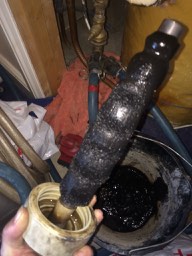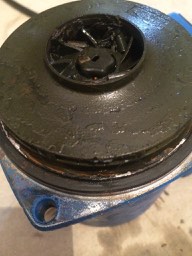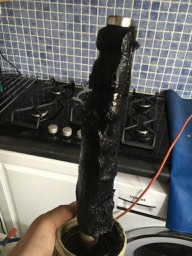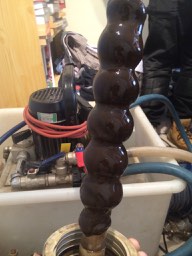Loading...
Power Flushing
What is Power Flushing?
Power Flushing is the process by which heating systems are forcibly cleansed using a chemical at high velocity, but low pressure, so that no physical damage is caused to the system.
The objective is to remove sludge and corrosion deposits from the system which cause damage to the boiler and pump, slowing down circulation which can lead to higher fuel costs.
In our experience, power flushing can make a dramatic difference to the operating efficiency of most systems.
Where a new boiler is to be fitted to an older system, cleansing is of utmost importance in order to remove layers of Magnetite and in hard water areas limescale.
If this is not done a Hi Efficiency boiler with a SEDBUK A or B rating would be brought down to a C or D rating, making the installation impracticable and resulting in early failure of the boiler.
A new boiler failing due to Magnite build up will result in the Manufactures warranty becoming invalid.
In order to give the system its full life expectancy, water treatment should always be carried out.
Why Should I Power Flush?
Before we get to the reasons why you should power flush a central heating system, let me ask you a simple question.
When you have the heating on full blast do you have a room or two, or even a few radiators that do not seem to be getting as warm as they once did? I bet the answer is probably a yes.
Just by rubbing the back of your hand a 3rd of the way up from the bottom of a radiator, you can feel the heat difference, when compared to the top of the radiator. Now feel across the whole radiator, typically there should only be a difference on 10degrees difference between the top and bottom of the radiator. If you have areas that are colder than the others, then the reason for these cold spots are down to Magnite (or Sludge as we like to say).
The video linked above or to the left (depending upon your device), was taken when we carried out a power flush in George Street, Basingstoke. In the video you can see use using a Thermal Digital Imaging camera to check out the heat map across that radiator.
Why did we do this? Before Thermal Cameras become a bit cheaper, we relied upon a digital laser thermometer, to see where cold spots are on the radiator, we still use that method, but we also use this method. The whiter the light the hotter the area is, the darker, the colder.
As you can see the efficiency of that radiator was cut by almost a 3rd, which will mean the householder would have the heating on for longer, as it would take longer to heat the room, mean while your gas meter was spinning away.
So where does the sludge come from???
Well, rust occurs in central heating systems, usually to no Corrosion Inhibitor being added to the system every 2 years, so things corrode, producing a black sludge or Magnite, and in hard water areas lime scale can build up just like in your kettle causing the following problems.
- Cold spots on radiators
- Noisy pump
- Pump failure
- Blocked radiators
- Radiators frequently needing venting and bleeding
- Boiler noise
- Heating circulation problems
- System is slow to heat up
- Reduced heating output
- Pinhole leaks from radiators
- Blocked inoperative or leaking radiator valves
When a new heating system is installed in your house, corrosion starts immediately. The oxygen in the water starts to attack the radiators internally. This chemical reaction eventually forms a black sludge (Magnite) that causes problems such as boiler noise, repeated pump failures or poor circulation and often all three!!!
So now you have an idea as to why you should powerflush a central heating system, especially if you are experiencing the issue above.
So lets get back to that radiator in George Street, Basingstoke shall we?
The video on the right or above, was taken, after we had fired up the central heating system, after carrying out a power flush.
As you can see the heat map covers the actual radiator, and has a differential of approximately 10 degress Celsius from top to bottom, proving that this is as clean as the radiator will get. Genius, or are we just that good.
Sludge! (Magnite Deposits)
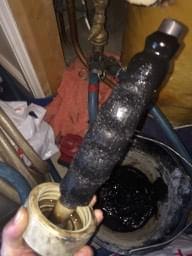
Commonly called "Sludge" Magnite deposits are the principle cause of system replacement.
It is present in the majority of heating systems as a thin, black liquid.
However, it is often thick and oily.
At this stage it is highly damaging to a system's performance and will ultimately cause system failure if left unchecked.
The image to the left was taken whilst the Power Flush machine was dumping the dissolved "Sludged" from the system before the final flush with fresh water and corrosion inhibitor, this system was 10 years old!
We have thousands of pictures taken whilst carrying out power flushing.
Those images can be found on our PowerFlush Gallery Here.
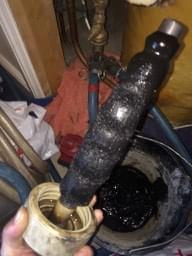
Some important things you need to know about powerflushing and why it is so important
Power Flushing is a rapid movement of water through the system, aided by the use of cleaning chemicals to remove deposits.
It is the only effective way to remove debris from the system.
Expelling the dirty water to drain and replacing with clean water from the mains supply, which can be done in either direction of flow.
After flushing the radiators the system water should be tested with a TDS meter and should be within 10% of the reading gained from the mains water.
The clean system is then ready for treatment with a corrosion inhibitor.
Without this treatment no guarantees can be given as to the life or efficiency of the system.
Who Says So?
Building Regulations - Part L refers to the Domestic Heating Compliance Guide.
This states that the minimum provision in new and existing dwellings is:
- Thorough cleaning and flushing out before installing a new boiler.
- During final fill add the corrosion and scale formulation (Corrosion Inhibitor).
Follow guidance given in BS 7593:2006. - Refer to boiler manufacturers instructions for appropriate treatment.
- Where hardness > 200ppm, treat feed water to water heaters and hot water circuit of combi to reduce limescale accumulation.
- Furthermore, many maintenance companies often insist that systems are powerflushed in order to maintain a cover plan.
Copyright 2010-2020 iPlumb Heating Services Ltd



